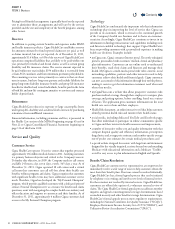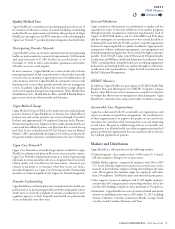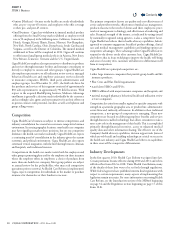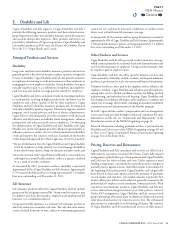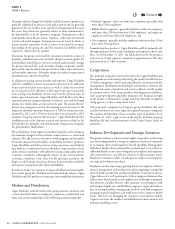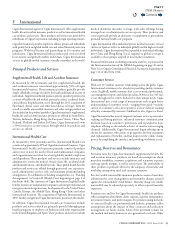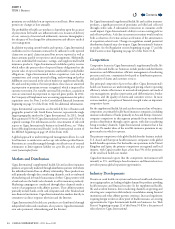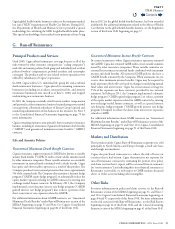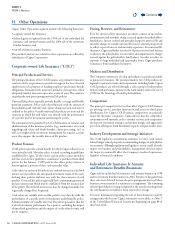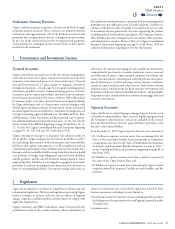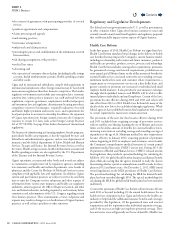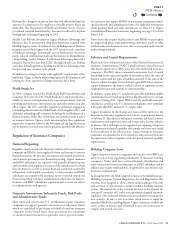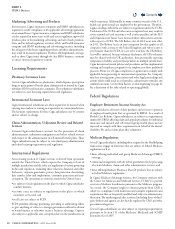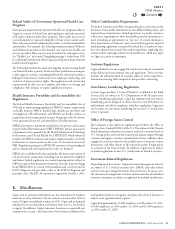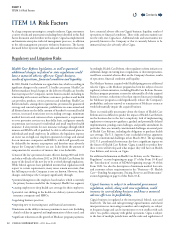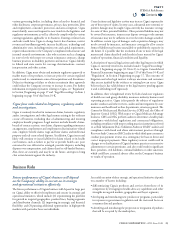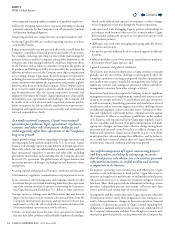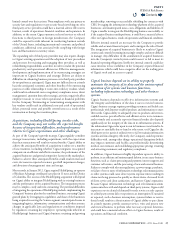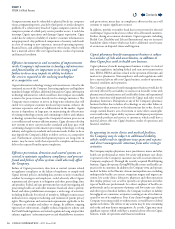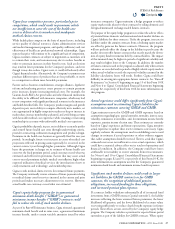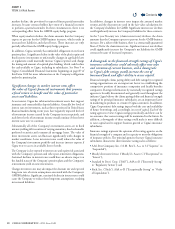Cigna 2011 Annual Report Download - page 40
Download and view the complete annual report
Please find page 40 of the 2011 Cigna annual report below. You can navigate through the pages in the report by either clicking on the pages listed below, or by using the keyword search tool below to find specific information within the annual report.
18 CIGNA CORPORATION2011 Form10K
PARTI
ITEM 1 Business
•
the content of agreements with participating providers of covered
services;
•producer appointment and compensation;
•claims processing and appeals;
•underwriting practices;
•reinsurance arrangements;
•unfair trade and claim practices;
•
protecting the privacy and condentiality of the information received
from members;
•risk sharing arrangements with providers;
•medical loss ratios;
•advertising; and
•the operation of consumer-directed plans (including health savings
accounts, health reimbursement accounts, exible spending accounts
and debit cards).
Cigna and its international subsidiaries comply with regulations in
international jurisdictions where foreign insurers may be faced with
more onerous regulations than their domestic competitors. e broader
regulatory environment may include anti-corruption laws, economic
sanctions laws, various privacy, insurance, tax, tari and trade laws and
regulations, corporate governance, employment, intellectual property
and investment laws and regulation, discriminatory licensing procedures,
compulsory cessions of reinsurance, required localization of records
and funds, higher premium and income taxes, and requirements for
local participation in an insurer’s ownership. In addition, the expansion
of Cigna’s operations into foreign countries increases the Company’s
exposure to certain U.S. laws, such as the Foreign Corrupt Practices
Act of 1977 (FCPA). See page20 for further discussion of international
regulations.
e business of administering and insuring employee benet programs,
particularly health care programs, is heavily regulated by state and
federal laws and administrative agencies, such as state departments of
insurance and the federal departments of Labor, Health and Human
Services, Treasury and Justice, the Internal Revenue Service as well as
the courts. Health savings accounts, health reimbursement accounts and
exible spending accounts are also regulated by the U.S. Department
of the Treasury and the Internal Revenue Service.
Cigna’s operations, accounts and other books and records are subject
to examination at regular intervals by regulatory agencies, including
state insurance and health and welfare departments, state boards of
pharmacy and the Center for Medicare & Medicaid Services to assess
compliance with applicable laws and regulations. In addition, Cigna’s
current and past business practices are subject to review by, and from
time to time the Company receives subpoenas and other requests of
information from, various state insurance and health care regulatory
authorities, attorneys general, the Oce of Inspector General, and other
state and federal authorities, including inquiries by, and testimony before
committees and subcommittees of the U.S. Congress regarding certain
of its business practices. ese examinations, reviews, subpoenas and
requests may result in changes to or clarications of Cigna’s business
practices, as well as nes, penalties or other sanctions.
Regulatory and Legislative Developments
e federal and state governments in the U.S. as well as governments
in other countries where Cigna does business continue to enact and
seriously consider many broad-based legislative and regulatory proposals
that could materially impact various aspects of Cigna’s business.
Health Care Reform
In the rst quarter of 2010, Health Care Reform was signed into law.
Health Care Reform mandates broad changes in the delivery of health
care benets that may impact the Company’s current business model,
including its relationship with current and future customers, producers
and health care providers, products, services, processes and technology.
Health Care Reform includes, among other requirements, provisions
for guaranteed coverage and renewal requirements, prohibitions on
some annual and all lifetime limits on the dollar amount of benets for
essential health services, increased restrictions on rescinding coverage,
minimum medical loss ratio and customer rebate requirements, a
requirement to cover preventive services on a rst dollar basis, and
greater controls on premium rate increases for individual and small
employer health insurance. It also provides for state insurance exchanges
through which qualied insurers and HMOs will be able to oer
insured plans to individuals and small employers. Certain of the law’s
provisions became eective during 2010 and 2011 and others will
take eect from 2012 to 2018. Health Care Reform left many of the
details of the new law to be established through regulations. While
federal agencies have published interim nal regulations with respect
to certain requirements, many issues remain uncertain.
e provisions of the new law that became eective during 2010
and 2011 included those requiring coverage of preventive services
with no enrollee cost-sharing, banning the use of lifetime and certain
limits on the dollar amount of benets for essential health services,
increasing restrictions on rescinding coverage and extending coverage of
dependents to the age of 26. Minimum medical loss ratio requirements
became eective in January2011, requiring payment of premium
rebates beginning in 2012 to employers and customers covered under
the Company’s comprehensive medical insurance if certain annual
minimum medical loss ratios (“MLR”) are not met. During 2011, the
Department of Health and Human Services (“HHS”) released interim
nal regulations that provided a special methodology for calculating the
MLR for 2011 for global health benets business and limited benet
plans while also stating that the agency intended to study the data in
determining whether special accommodations would be made for these
plans in 2012 and future years. On December2,2011, HHS issued
revised regulations on the MLR provisions of Health Care Reform.
e special methodology for calculating the MLR for limited benet
plans has been extended through 2014. e special methodology for
calculating the MLR for global health benet plans has been extended
indenitely.
Certain other provisions of Health Care Reform will not become eective
until 2013 or beyond, including: (1) the annual health insurer fee on
health services companies such as Cigna and others in the health care
industry to help fund the additional insurance benets and coverages
provided by this legislation; (2) the guaranteed issue and renewal
requirements and the requirement that individuals maintain coverage,
and (3) the excise tax on high-cost employer-sponsored coverage. ese
fees and excise taxes will generally not be tax deductible. Health Care
Contents
Q


